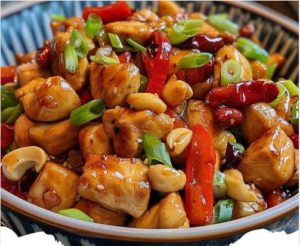
Here are some frequently asked questions related to Kung Pao Chicken along with their answers:
1. What is Kung Pao Chicken?
Answer: Kung Pao Chicken is a classic Chinese stir-fry dish that features tender pieces of chicken stir-fried with vegetables, peanuts, and a flavorful sauce. The sauce typically includes soy sauce, vinegar, sugar, and chili peppers, giving it a balanced sweet, salty, tangy, and spicy taste.
2. Is Kung Pao Chicken spicy?
Answer: Yes, Kung Pao Chicken is known for its spicy flavor. It typically includes chili peppers or chili garlic paste in the sauce, which adds heat to the dish. You can adjust the spiciness by controlling the amount of chili peppers or paste used.
3. Can I use chicken thighs instead of chicken breasts?
Answer: Yes, you can substitute boneless, skinless chicken thighs for chicken breasts in Kung Pao Chicken. Thighs are often preferred for their juiciness and can add a slightly richer flavor to the dish.
4. How do I make Kung Pao Chicken less spicy?
Answer: To make Kung Pao Chicken less spicy, you can reduce or omit the chili peppers or chili garlic paste in the sauce. You can also use a milder variety of chili peppers or adjust the amount to suit your taste preferences.
5. What vegetables can I use in Kung Pao Chicken?
Answer: Common vegetables used in Kung Pao Chicken include bell peppers (red, green, or yellow), snap peas, carrots, zucchini, and water chestnuts. These vegetables add color, texture, and flavor to the dish.
6. How do I thicken the sauce for Kung Pao Chicken?
Answer: To thicken the sauce for Kung Pao Chicken, mix cornstarch with water to create a slurry. Add the slurry to the stir-fry towards the end of cooking and stir well. Cook for a minute or two until the sauce thickens to your desired consistency.
7. Can I make Kung Pao Chicken ahead of time?
Answer: While Kung Pao Chicken is best served fresh and hot, you can prepare some components ahead of time. You can marinate the chicken in advance and chop the vegetables. However, it’s recommended to stir-fry and assemble the dish just before serving to maintain its texture and flavors.
8. What can I serve with Kung Pao Chicken?
Answer: Kung Pao Chicken is traditionally served with steamed white rice to soak up the flavorful sauce. You can also serve it with noodles such as chow mein or rice noodles for a complete meal.
9. How do I store leftovers of Kung Pao Chicken?
Answer: Store leftover Kung Pao Chicken in an airtight container in the refrigerator for up to 3-4 days. Reheat gently in a skillet or microwave until warmed through before serving.
10. Can I make Kung Pao Chicken without peanuts?
Answer: Yes, if you have a peanut allergy or prefer not to use peanuts, you can omit them from the recipe. The dish will still have the characteristic flavors of Kung Pao Chicken from the sauce and other ingredients.
These answers should cover the most common questions you may have about making and enjoying Kung Pao Chicken at home!
